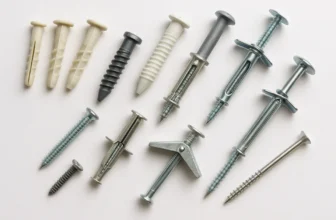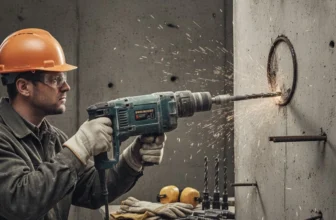Choosing the correct drywall anchor can be the difference between a secure installation and a damaged wall. Many homeowners rely on basic screws and hope for the best, only to see shelves sag, frames tilt, or anchors pull out over time. A well-matched anchor ensures the weight is supported properly and prevents unnecessary repairs later. Whether you’re mounting a small picture frame or a heavy cabinet, the right anchor makes the job easier and safer.
What Is a Drywall Anchor?
A drywall anchor is a small hardware device designed to hold screws securely in drywall. Since drywall alone has very weak grip strength, screws inserted directly into it often loosen or pull out. Anchors solve this problem by expanding, locking, or distributing pressure behind the wall surface, creating a reliable point of support.
In many cases, an anchor is the only way to hang something where no stud is available. Studs are strong, but they don’t always line up with your desired placement. For wall décor, shelving, mirrors, bathroom accessories, and small to medium furniture mounts, anchors become essential.
Key Factors to Consider Before Choosing a Drywall Anchor
Selecting the right anchor type starts with understanding your project. Each anchor is built for a specific load range, wall condition, and installation style. The more carefully you match these factors, the safer and cleaner your results become.
1. Weight Capacity
Weight rating is the most important detail. Every anchor type handles a different load range, from a few pounds to well over a hundred. Light-duty anchors handle everyday décor items, while heavier versions support shelves, racks, or large frames.
- Light loads (up to 10–15 lbs): Small picture frames, clocks, or decorative signs
- Medium loads (15–40 lbs): Mirrors, small shelves, curtain rods
- Heavy loads (40+ lbs): Cabinets, large framed art, TV mounts
Choosing an anchor rated too low can lead to sagging or wall tears. Always check the manufacturer’s rating and go higher if you’re unsure. It’s also helpful to factor in dynamic pressure. For example, coat hooks experience repeated pulling, so they require stronger anchors than a frame of equal weight.
2. Wall Type and Condition
Not all drywall is identical. Standard drywall varies in thickness, and older walls may be more brittle. Moisture-resistant drywall, often seen in bathrooms, can also change how anchors perform. Thick walls handle heavier-duty anchors well, while thin walls may need anchors that expand rather than exert too much pressure.
If the drywall feels soft, chalky, or crumbly, extremely aggressive anchors may cause further damage. For weak walls, gentle expansion anchors or toggle-style systems often work better.
3. Type of Item You Want to Hang
Different items create different stresses. Static items, such as paintings, apply a steady load. Dynamic items, such as towel bars, coat hooks, or cabinet doors, introduce extra force because they’re pulled or moved repeatedly. For any dynamic load, choosing an anchor with a strong locking mechanism is essential.
A good rule:
If you’ll grab it, pull it, or bump into it, go a level stronger than the item’s basic weight requires.
4. Installation Skill Level and Tools Available
Some anchors are simple enough to install with a screwdriver, while others require drilling or special tools. Beginners often prefer self-drilling anchors because they eliminate pilot holes. Experienced DIY users might choose toggles or mollies for stronger support.
Matching complexity to your comfort level helps you avoid mistakes like oversized holes, poorly seated anchors, or cracked drywall.
Types of Drywall Anchors: Pros, Cons, and Best Uses
Understanding the different anchor types helps you match each one to your project requirements. Each design offers unique strengths and limitations.
Plastic Expansion Anchors
These are the most common and budget-friendly options. They work by expanding slightly as the screw is driven in. They’re best suited for light-duty applications such as small frames or switch plates.
Pros:
- Inexpensive
- Easy to install
- Widely available
Cons:
- Not suited for medium or heavy loads
- Can pull out if overloaded
- Not ideal for weak drywall
Best used when the item is small and light, and when your wall is in good condition.
Self-Drilling (Threaded) Anchors
Also known as “zip” or “spiral” anchors, these are designed with a sharp tip that cuts into drywall without needing a pilot hole. They come in plastic or metal versions. Metal versions are stronger and can hold medium-weight items securely.
Pros:
- Simple installation
- Stronger grip than plastic expansion anchors
- Good for moderate loads
Cons:
- Can crack brittle drywall if forced
- Plastic versions may strip during installation
These are ideal for everyday household use, such as mounting shelves, curtain brackets, and medium frames.
Toggle Bolts
Toggle bolts use a spring-loaded wing that folds and opens behind the drywall. Once expanded, they distribute weight across a wide area, allowing for high load capacity.
Pros:
- Excellent for heavy items
- Very secure behind the wall
- Works well even in older drywall
Cons:
- Requires a larger hole
- Wings cannot be retrieved if removed
- Slightly more complex to install
This option shines when mounting heavy mirrors, cabinets, and wall-mounted furniture.
Molly Bolts (Hollow Wall Anchors)
Molly bolts have a metal sleeve that expands behind drywall when the screw tightens. They create a strong, reusable anchor point.
Pros:
- Strong metal construction
- Good for medium to heavy loads
- Often reusable
Cons:
- Requires precise pilot hole
- Takes longer to install
These anchors work well for frequently used fixtures like coat hooks, shelving brackets, or larger décor.
Specialty Anchors and Hybrid Designs
Products such as snap toggles or heavy-duty wall grips provide extra stability while keeping installation simple. They combine the strength of toggles with easier installation processes.
These are helpful when you need above-average support but want to avoid drilling oversized holes.
How to Match Anchor Type With Project Requirements
Matching an anchor to a task becomes easier once you understand the weight categories and load behavior of your item.
Light Items (Switch Plates, Small Frames, Clocks)
Plastic expansion anchors or small threaded anchors are enough. They create a snug fit without damaging the wall and install quickly.
Medium-Weight Items (Mirrors, Shelves, Curtain Rods)
Metal self-drilling anchors or small molly bolts handle these loads well. Choose anchors rated for slightly more than the actual weight.
Heavy Items (TV Mounts, Cabinets, Large Mirrors)
Toggle bolts or heavy metal mollies are the safest choice. The wider load spread ensures a secure hold. For extreme loads, locating a stud is still recommended.
Step-by-Step Guide to Choosing the Right Drywall Anchor
A simple process can help you match the perfect anchor to any project. Following a clear sequence prevents wasted effort, oversized holes, or anchors that loosen over time.
Step 1: Identify the Weight and Load Type
Start by checking the item’s weight. Many products list their weight on the box or online. If the item has moving parts or will be pulled often, treat it as a heavier load. For example, a towel bar may weigh little but faces repeated pulling, so it requires a stronger anchor.
Step 2: Inspect the Drywall Condition
Press gently around the installation area. If the surface feels soft or crumbly, choose an anchor that spreads pressure widely—toggle bolts or metal mollies work best in this situation. Fresh, firm drywall can support standard threaded anchors and expansion plugs.
Step 3: Choose the Anchor Type
Match your anchor selection with the information you gathered. Light items pair with simple plastic anchors, while medium loads suit metal threaded anchors or small mollies. Heavy objects need toggle-style systems or anchors that lock firmly behind the wall.
Step 4: Match the Screw Length and Diameter
A strong anchor needs the correct screw. Too short, and the hold weakens; too long, and it may bottom out behind the wall. Most anchors include compatible screws, so it’s best to use those. If replacing, match the screw size exactly with the anchor’s instructions.
Step 5: Prepare the Wall
If your anchor requires a pilot hole, drill it cleanly without wobbling the bit. For self-drilling anchors, apply steady pressure and avoid overtightening. Keeping the hole straight ensures the anchor seats properly.
Step 6: Insert the Anchor and Test the Fit
Once installed, press or gently pull on the anchor to confirm it feels firm. If it wiggles or rotates freely, remove it and choose a larger size or switch to a more secure anchor type.
Step 7: Mount the Item Safely
After installing the screw and anchor, hang your item and apply light pressure to test stability. If everything feels solid, the job is complete.
Common Mistakes to Avoid
Drywall installations often fail due to avoidable errors. Here are the issues most people run into:
Using an Anchor Below Its Weight Rating
Overloading is the number one cause of wall damage. Always choose an anchor that safely exceeds the actual load. It’s better to go slightly stronger than necessary.
Skipping Pilot Holes When Required
Some anchors require precise pilot holes. Skipping this step can cause the anchor to split the drywall or sit unevenly.
Using Plastic Anchors for Dynamic Loads
Light plastic anchors work for frames but fail quickly when used on coat hooks, towel racks, or shelves. Choosing a stronger type prevents early loosening.
Ignoring Studs When Available
If a stud happens to align with your mounting point, use it. Even the strongest drywall anchor is weaker than a stud. For very heavy items, combining a stud with an anchor on the opposite side provides balanced support.
Installing in Damaged or Moisture-Weakened Drywall
Soft drywall will not hold most anchors securely. In these cases, using toggle bolts or finding a stud is the safest path.
Tips for Safe Installation
A few small precautions help keep your wall in great shape and ensure a long-lasting result.
Check for Hidden Wires or Pipes
Use a stud finder with wire detection or drill very gently at first. This minimizes risk when working near kitchens or bathrooms.
Use Proper Drilling Speed
High speed can tear paper layers on drywall. A slow, steady approach keeps the hole clean.
Ensure a Snug Fit
Anchors should fit tightly. If the hole becomes too large, step up to the next anchor size rather than forcing the small one.
Test the Load Gradually
After hanging the item, apply gentle pressure before putting full weight on it. This quick test reveals any loose anchor issues early.
Recommended Drywall Anchors (Quick Buying Guide)
Here is a simple overview to help you choose anchors confidently:
Light-Duty Anchors
- Plastic expansion anchors
- Small plastic threaded anchors
Best for: small décor, signs, and lightweight frames.
Medium-Duty Anchors
- Metal threaded anchors
- Small molly bolts
Best for: curtain rods, medium frames, bathroom accessories.
Heavy-Duty Anchors
- Toggle bolts
- Large metal mollies
- Snap toggle anchors
Best for: cabinets, large mirrors, floating shelves, and TV mounts.
A quick chart helps summarize:
| Weight Range | Best Anchor Types | Example Use |
|---|---|---|
| 0–15 lbs | Plastic expansion, small threaded | Clocks, tiny frames |
| 15–40 lbs | Metal threaded, small mollies | Shelves, mirrors |
| 40–100+ lbs | Toggle bolts, heavy mollies | Cabinets, large mirrors |
Conclusion
Choosing the correct drywall anchor is a simple process once you understand weight requirements, wall condition, and item type. With the right anchor matched to the right task, you can mount everything from light décor to heavy furniture with confidence. It saves time, protects your walls, and prevents accidents or damage down the road. A thoughtful choice ensures that every installation stays secure and looks clean for years.
Hi, I’m Charles Larson. We do everything we can to support our readers with hundreds of hours of research and comparison testing to ensure you find the perfect tool for your workshop.







